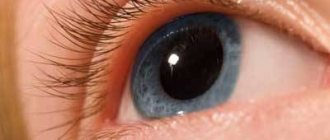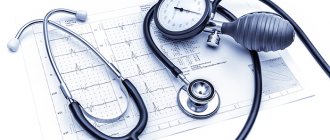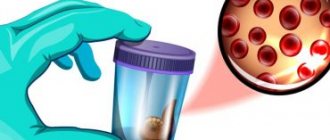The signs of a neurotic disorder are variable and imprecise; each person’s neurosis can manifest itself differently. Therefore, in order to accurately establish a diagnosis and receive adequate treatment, you need to consult a psychotherapist.
Important
A psychotherapist diagnoses neurosis. The treatment regimen that will help cope with the disorder depends on the type of neurosis and its severity.
Neurosis is a functional disease of the nervous system. This means that the disorder occurs temporarily; there is no infection, tumor, or persistent pathology of blood vessels or internal organs in the body. Negative factors deplete the nervous system:
- stress;
- overvoltage;
- internal conflict;
- traumatic situation.
This causes disturbances in the functioning of the heart and blood vessels, indigestion, strange pain and discomfort in different parts of the body. Somatologists (who deal with diseases of the body - therapists, neurologists) do not find any abnormalities: neither peptic ulcers, nor abnormalities of the endocrine system (for example, the thyroid gland), nor inflammation.
Manifestations of neurosis in adults are often confused with other diseases, so most patients undergo examinations for years, but treatment does not produce results. In such cases, it is recommended to consult a psychotherapist.
The body is healthy with neurosis, most tests are normal. “All diseases come from nerves” - that’s exactly what it’s about.
How to recognize neurosis? It is characterized by the following symptoms:
- somatic manifestations (from the body) - vague pain, increased fatigue, changes in blood pressure, fever, sweating;
- emotional instability - frequent unreasonable or causeless anxiety, fear, irritability, tearfulness;
- poor load tolerance - a person cannot concentrate, sometimes cannot sit still. Both work and personal life suffer; basic tasks become tiresome very quickly.
In the next part we will take a closer look at how neurosis manifests itself and what specific symptoms and complaints are possible.
Heart spasms - possible causes
The sources of the pathological condition characterized by problems with the functioning of the heart muscle have not been fully studied. Young women and adolescents are more often at risk. It should also be noted that there is an increased risk of an attack for people suffering from blood disorders (poor clotting).
In addition to capillary angina, spasm of the heart vessels can be caused by:
- vascular changes resulting from syphilis, rheumatoid diseases;
- various infections and allergic reactions to external irritants;
- some diseases of the gastrointestinal tract.
A separate group can be divided into a cause such as atherosclerosis. The disease negatively affects the patency through the coronary arteries, thereby significantly increasing the likelihood of cardiovascular spasm.
Manifestations of the pathological condition
Most often, heart spasm provokes pain and a feeling of heaviness in the chest area. Angina pectoris can cause an attack, both at rest and during overexertion. Symptoms often spread to other important body systems. Patients complain of increased heart rate, breathing problems, nausea, loss of orientation in space, and abnormal sweating.
Most doctors recommend dividing heart muscle cramps into two groups.
- A spasm of the heart muscle that occurs with a sharp increase in physical activity (angina pectoris) usually causes symptoms such as severe pain and a feeling of shortness of breath. Signs of the disease may appear periodically throughout the month.
- A spontaneous attack often takes a person by surprise. The painful signs of artery compression usually appear in the early morning or at night without physical or emotional overload.
It is possible to determine that a person has a heart spasm by external signs. Usually the patient’s skin color changes (turns pale), and the hands become cold. If the described manifestations are accompanied by chest pain, you should immediately call an ambulance or transport the person to a medical facility yourself.
How to define neurosis
Symptoms depend on the form of neurosis. The most common manifestations of the body and psyche are:
- sleep disorders;
- indigestion;
- breathing problems, feeling of suffocation;
- disruption of the heart and blood vessels;
- vegetative symptoms - trembling, convulsions, sweating, temperature changes, even pain.
One of the first possible signals is sleep disturbances. Difficulty falling asleep, shallow or restless sleep, frequent awakenings. The feeling of tension in the head during neurosis is a consequence of the fact that at night the nervous system is not fully restored. Sleep disorders lead to constant tension and emotional breakdowns.
The digestive system is sensitive to psychological traumatic factors. She reacts with loss of appetite, flatulence, frequent pain and discomfort in the abdomen, and problems with stool. In this case, the person has neither an ulcer nor an intestinal infection. A common manifestation is nausea during neurosis, which is accompanied by a feeling of dry mouth.
Important
The nervous system is connected to all internal organs, so with neurosis the entire body suffers. The opposite is also true: if you give a specialist the opportunity to cure the psyche, the physical symptoms will also disappear.
With neuroses, there are breathing problems: typical complaints are lack of air, difficulty inhaling or exhaling, and suffocation. Sometimes a person feels like he has forgotten how to breathe. It is often observed when you find yourself in a conflict or emotionally significant situation.
From the cardiovascular system, hypertensive crises, heart rhythm disturbances, and discomfort in the chest area may be observed. Tachycardia with neurosis is a common complaint.
The nervous system takes the main “blow” under constant stress. A person experiences tremors in the body during neurosis, frequent headaches, hot flashes, muscle cramps, changes in sensitivity (numbness of the limbs). Sometimes he may complain that he feels dizzy for no reason.
All changes in neurosis are functional, that is, reversible. With adequate treatment, patients recover completely.
Mentally, a person becomes depressed, cannot concentrate for a long time, and memory decreases. The level of anxiety increases, and overly violent emotional reactions are possible. With psychoneuroses, there are no hallucinations, but sometimes there is tinnitus.
If it is necessary to sit quietly for some time, a person with neurosis experiences discomfort. To calm himself down, he begins to tap his pen, play with an item of clothing, and fidget with his fingers.
How to relieve heart spasms
First of all, it is necessary to make sure that the causes of the pathology lie precisely in the arteries. Heart spasm can be diagnosed by performing a hardware scan. To confirm concerns, you will have to undergo an electrocardiogram (determining the ST interval), daily monitoring or echocardiography.
Bicycle ergometry and laboratory blood samples to identify cardiac troponins and other markers indicating severe myocardial damage would be useful.
Unfortunately, there is no clear answer to the question of how to relieve cardiac muscle spasm. Therapy is selected individually, taking into account the physical characteristics of the patient and the presence of concomitant diseases. People at risk are advised to carry nitroglycerin with them. If pain occurs in the chest area, you should take this drug in the form of a tablet or a diluted alcohol solution. Usually unpleasant symptoms disappear after a few minutes.
Heart spasms can be the first sign of a dangerous vascular disease. If there are irremovable negative factors (bad heredity, age), a cardiologist or arrhythmologist can prescribe preventive treatment. The most commonly prescribed drugs are anti-ischemic drugs, calcium channel blockers, antioxidants, and anti-sclerotic substances.
What to do if heart spasm becomes a symptom of a serious illness? Surgical treatment is recommended when dangerous arterial defects are identified and when pharmacological effects are low.
- Angioplasty is an operation using a special catheter that expands the lumen of the ducts.
- Coronary bypass surgery is the restoration of blood flow by implanting a “bypass branch” of the circulatory system.
Today, the stenting method is increasingly used. If cardiac spasm occurs due to weakness of the vessel walls, then a special tubular mesh is installed in it, which ensures blood flow.
Diagnosis of heart pain
An experienced doctor can determine its origin based on the description of the pain. But to confirm the diagnosis you need to undergo an examination. First of all, an electrocardiogram (ECG) is done, including with physical activity. If no abnormalities are detected, the ECG is recorded throughout the day (24-hour monitoring).
If pain in the heart appears after a sore throat, then an ECG, echocardiography (ultrasound examination of the heart), and blood tests are required, which can reveal inflammation in the heart muscle.
If you have pain in the heart area, be sure to consult a doctor - he will help you figure out how serious it is. What methods are used today to study cardiac activity? There are quite a few of them, and the specific diagnostic set in each case is determined by the attending physician.
- The well-known ECG - taking a cardiogram - is a mandatory technique for any suspicion of heart disease. Stress ECG is also widely used - recording data during physical activity (usually velometry or treadmill test), as well as Holter ECG (when an electrocardiogram is taken during the day).
- Often, the doctor prescribes a graphical recording of heart sounds and noises (phonocardiography), a study of the valves and muscles of the heart, as well as the speed of blood flow in the heart cavities using ultrasound waves (echocardiography). Coronary arteries are studied using a radiopaque method (coronary angiography). How well the myocardium is supplied with blood can be determined by radionuclide diagnostics (scintigraphy).
- To exclude damage to other organs as the cause of heart pain, patients are prescribed a spinal examination (X-ray, computed tomography, MRI), consultation with an orthopedist, neurologist, gastroenterologist, and even a psychotherapist.
Experienced doctors know that some (and fairly accurate) conclusions can be drawn by listening carefully to the patient. When a person describes his feelings in detail, keeps and shows the doctor a kind of diary of the occurrence and nature of pain in the heart area, most likely the heart itself has nothing to do with it. Also, an “external” source of pain is indicated by patient reports of varying durations of attacks, a strong and very disturbing heartbeat - of course, if the person does not have heart failure. But if the patient perfectly remembers all his painful sensations, but describes them sparingly and reluctantly, there is a high chance of diagnosing serious heart disease.
In any case, remember: the main thing to do if your heart hurts is to consult a specialist and give him the right to draw conclusions about your health.
Heart pain can be a consequence of cardioneurosis, a disease of the nervous system. They intensify under stress and have a constant aching character. Such pain is relieved with sedatives (for example, valocardine or valerian). But you need to remember that only a doctor can make a diagnosis of cardioneurosis after an examination.
Pain in the heart due to inflammation of the heart muscle (myocarditis) is prolonged, aching, sometimes it is combined with stabbing pains, they are usually felt not behind the sternum, but to the left of it. The pain intensifies with physical activity, usually combined with shortness of breath, a feeling of “interruptions” in the heart’s work and its “fading”, weakness, malaise, and sometimes with a slight fever. Such pains often appear 2-3 weeks after a sore throat or other illness. You can’t joke with these pains - you need to see a doctor immediately, the treatment will be long-term.
Heart pain can occur when the arteries that supply nutrients and oxygen to the heart muscle spasm (compress). Such attacks of pain are called angina pectoris, they are very dangerous and cannot be tolerated.
Prevention of angina
It is important to understand that spasm of the heart muscle can cause myocardial infarction. Probably everyone knows that such an attack often becomes fatal. What to do and how to avoid danger?
People at risk due to congenital pathologies and age will have to take special medications that support general health.
If no irremovable provoking factors are found, then you just need to give up bad habits (especially smoking), normalize your weight if necessary, and limit your consumption of fatty and starchy foods. Periodic physical activity (walks in the fresh air, active sports) and monitoring of your psycho-emotional state will not be superfluous.
Angina pectoris
Attacks of angina pectoris occur first during exercise or stress (this is called angina pectoris), and then at rest (rest angina pectoris). In typical cases, the pain is squeezing or pressing in nature and manifests itself either in the upper part of the sternum or to the left of it. Pain can radiate to the left arm, the left half of the face and neck, to the lower jaw, left ear, to the left shoulder blade, sometimes to the right shoulder or both shoulders and both arms, and the back. Sometimes the pain spreads to the left side of the abdomen and lower back, and to the legs. The onset of pain is rarely sudden; usually the pain is of an increasing nature, lasts for several minutes, then disappears. This pain is different in that it can be relieved with nitroglycerin, a drug that relieves spasm of the coronary arteries (which supply blood to the heart muscle).
If such pain occurs at least once, the patient should consult a doctor, get examined and clearly know what to do during an attack. During an attack of angina, you need to:
- take a nitroglycerin tablet (under the tongue);
- lie down, open a window or window;
- if after 2 minutes the pain has not decreased, then take another nitroglycerin tablet and call an ambulance. Nitroglycerin begins to act within 1-2 minutes, its vasodilating effect lasts 20-30 minutes. Remember: neither Corvalol nor validol will help with angina - only nitroglycerin!








